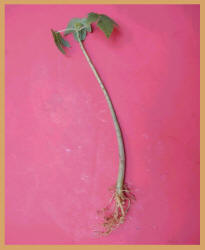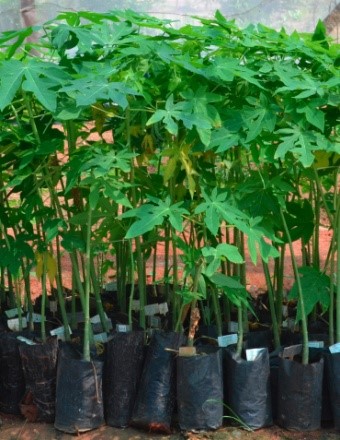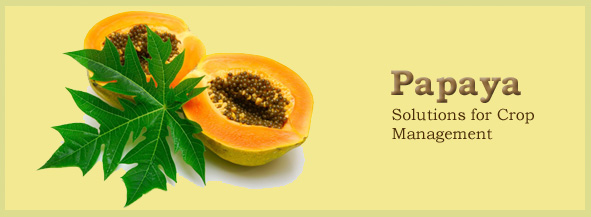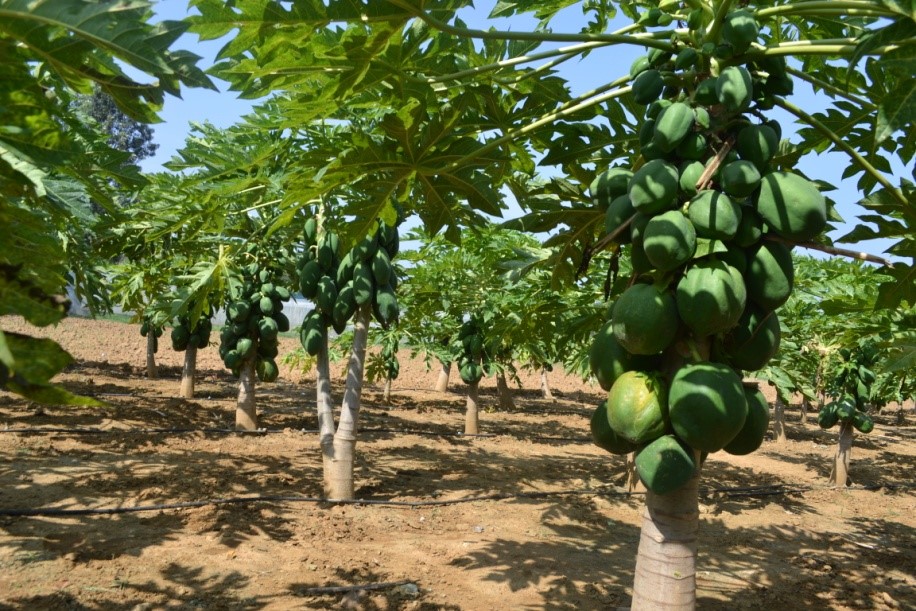Nematodes
in papaya
Papaya crop in many farmers’ fields has been observed to
have infestation of
 nematodes viz. Meloidogyne incognita, M.
javanica (root-knot nematodes) and Rotylenchulus
reniformis reniform nematode). These nematodes are
microscopic and infect Papaya starting from nursery stage.
Further, they are also infected with other pathogenic fungi and
bacteria. Once these seedlings are infested the pathogen reaches
the farmers field and cause the diseases in their fields. Hence,
it is important to know how to produce healthy seedlings of
papaya. For controlling the diseases farmers use chemical
pesticides which are expensive and also are hazardous. nematodes viz. Meloidogyne incognita, M.
javanica (root-knot nematodes) and Rotylenchulus
reniformis reniform nematode). These nematodes are
microscopic and infect Papaya starting from nursery stage.
Further, they are also infected with other pathogenic fungi and
bacteria. Once these seedlings are infested the pathogen reaches
the farmers field and cause the diseases in their fields. Hence,
it is important to know how to produce healthy seedlings of
papaya. For controlling the diseases farmers use chemical
pesticides which are expensive and also are hazardous.
Papaya seedlings are produced generally in substrate mixture in polythene bags.
Many a times substrate mixture (sand + soil + FYM or any organic
manure) harbor above mentioned nematodes and other pathogenic
fungi and bacteria. Generally papaya seedling producers don’t
treat the soil mixture which is used for the production of
papaya seedlings in their nurseries.
As such nematode infestation on the
seedlings makes the way for the entry of various pathogenic
fungi and bacteria. These nematodes and other pathogens multiply
in the farmers' fields. As a consequence, soil in the farmers’
field becomes sick and un-productive and ultimately soil becomes
unfit for the cultivation over a period of time if proper
measures are not taken to combat these nematodes and other
pathogens.
Management of nematodes in
papaya
Application in new
planting
1. Seed
treatment
Pre-coat seeds with biopesticide
before sowing.
• Add biopesticide
Pseudomonas fluorescens at 20 ml/kg or 20 g/kg seed.
2. Substrate treatment
Preparation
for raising seedlings.
•  For substrate (propagating mixture) used in portrays/polybags
mix biopesticide
Pseudomonas fluorescens at 2 g/kg of substrate (cocopeat/
potting mixture) and fill in portrays/polybags. For substrate (propagating mixture) used in portrays/polybags
mix biopesticide
Pseudomonas fluorescens at 2 g/kg of substrate (cocopeat/
potting mixture) and fill in portrays/polybags.
• For nursery beds drench with 3 lit of
Pseudomonas fluorescens
suspension / m2 (add 5ml or 5g of formulation / lit
of water) before sowing seeds.
3. Bed treatment
Preparation of main field before
planting/ transplanting
• Enrichment of FYM with bio-pesticides: Mix two kg each of
Paecilomyces
lilacinus, Pseudomonas fluorescens
and Trichoderma harzianum
/ T. viride in one ton of FYM and leave it in shade for 15
days at 25 – 30% moisture for multiplication of beneficial
microbes.
•
Soil has to be incorporated with 20 – 30 tons of FYM enriched
with bio-pesticides before planting/ transplanting seedlings.
Application in standing crop
• Enrich neem cake with bio-pesticides: Mix two kg of each
of
Paecilomyces lilacinus, Pseudomonas fluorescens
and Trichoderma harzianum
/ T. viride in one ton of neem cake and leave it in shade
for 15 days at 25 – 30% moisture for multiplication of
beneficial microbes.
• Apply neem cake enriched with biopesticides in standing
crop at 50 g/ m2 once in a month.
•
Mix 20 kg of enriched neem cake mixture in 200 lit water, leave
it for two days and this can be used for drenching beds @ 2
lit/ m2 or filter it thoroughly and use it for spraying the
foliage or sending along the drip, once in a month.
• Spray Arka Plant Growth Promoter
and Yield Enhancer (Pseudomonas
fluorescens + Trichoderma harzianum) at 5 ml or 5g/lit, once
in a month. Or send along the drip, Arka Plant
Growth Promoter and Yield Enhancer (Pseudomonas
fluorescens + Trichoderma harzianum) at 5 ml or 5g/lit, once
in a month.
|








 nematodes viz. Meloidogyne incognita, M.
javanica (root-knot nematodes) and Rotylenchulus
reniformis reniform nematode). These nematodes are
microscopic and infect Papaya starting from nursery stage.
Further, they are also infected with other pathogenic fungi and
bacteria. Once these seedlings are infested the pathogen reaches
the farmers field and cause the diseases in their fields. Hence,
it is important to know how to produce healthy seedlings of
papaya. For controlling the diseases farmers use chemical
pesticides which are expensive and also are hazardous.
nematodes viz. Meloidogyne incognita, M.
javanica (root-knot nematodes) and Rotylenchulus
reniformis reniform nematode). These nematodes are
microscopic and infect Papaya starting from nursery stage.
Further, they are also infected with other pathogenic fungi and
bacteria. Once these seedlings are infested the pathogen reaches
the farmers field and cause the diseases in their fields. Hence,
it is important to know how to produce healthy seedlings of
papaya. For controlling the diseases farmers use chemical
pesticides which are expensive and also are hazardous.




